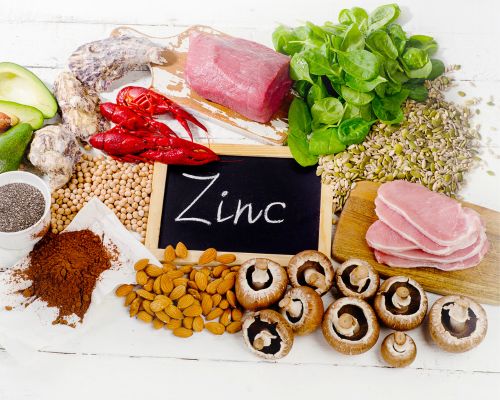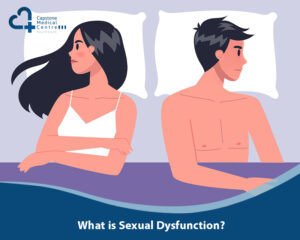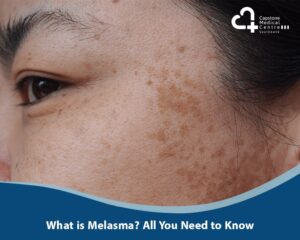
Yellow Fever
Yellow fever is a disease that spreads through the bites of Aedes and Haemagogus mosquitoes, which are carriers of an arbovirus. This illness …


MD, FRACGP, FACAM
Advance Diploma in General Dermatology
Diploma of Cosmetic Medicine

Zinc is a vital mineral found naturally in certain foods, added to others, and available as a dietary supplement. It’s also present in some cold lozenges, over-the-counter cold medications, and denture adhesive creams.
This mineral plays a crucial role in cellular metabolism, being necessary for the function of hundreds of enzymes. It enhances immune function, aids in protein and DNA synthesis, promotes wound healing, and is involved in cell signaling and division. Zinc is also important for growth and development during pregnancy, infancy, childhood, and adolescence and contributes to the sense of taste.
Women typically have about 1.5 grams of zinc in their bodies, while men have around 2.5 grams, mostly stored in skeletal muscle and bone.
Zinc homeostasis involves dietary absorption, excretion into the gastrointestinal tract, and reabsorption in the gastrointestinal lumen. As dietary zinc intake increases, absorption also rises, but the rate of absorption decreases.
Clinical assessment of zinc status usually involves measuring serum or plasma zinc levels, with normal ranges being 80 to 120 mcg/dL. Levels below 70 mcg/dL in women and 74 mcg/dL in men suggest inadequate zinc status. However, these measures have limitations, as serum zinc concentrations can be influenced by factors like sex, age, time of day, and dietary or supplemental intake. Additionally, zinc levels vary with other factors, including infections, hormonal changes, and muscle breakdown during weight loss or illness.
Clinicians also consider risk factors like poor caloric intake, chronic alcohol use, and malabsorptive digestive diseases, along with signs of zinc deficiency such as impaired growth in infants and children, to evaluate zinc status.
The Dietary Reference Intakes (DRIs) provided by the Food and Nutrition Board (FNB) at the National Academies of Sciences, Engineering, and Medicine offer intake recommendations for zinc and other nutrients. DRIs are a collection of reference values used for planning and assessing the nutrient intakes of healthy people, and these recommendations vary depending on age and sex. The key categories include:
Estimated Average Requirement (EAR): This is the average daily intake level estimated to satisfy the needs of 50% of healthy individuals. It is used primarily to evaluate the nutrient intakes of populations and to plan nutritionally adequate diets for groups; it can also be used for individuals.
Tolerable Upper Intake Level (UL): This is the highest daily intake amount that is unlikely to cause adverse health effects.
Zinc is predominantly found in various foods, with the richest sources being meats, fish, and seafood. Oysters stand out as the food with the highest zinc content per serving, although beef is a major contributor to zinc intake in the United States, accounting for about 20% of zinc from food due to its frequent consumption.
Eggs and dairy products are also good zinc sources. Beans, nuts, and whole grains contain zinc, but its bioavailability is lower from these plant-based foods compared to animal sources.
This reduced bioavailability is due to the presence of phytates, a form of phosphorus in plants, which bind to minerals like zinc in the intestine, creating an insoluble complex that hinders zinc absorption. Conversely, fruits and vegetables are relatively low in zinc.
In the U.S., breakfast cereals often fortified with zinc are a significant zinc source. For U.S. children and adolescents, enriched and fortified foods contribute between 12.1% to 18.4% of their daily zinc intake.
The absorption rate of zinc from food varies widely, from as low as 5% to over 50%, depending on the amount of phytate-rich plant-based foods in the diet. The absorption of zinc from diets that include a mix of animal-based and plant-based foods is generally lower than from diets consisting predominantly of animal-based foods.
A table detailing various foods and their zinc content per serving can provide specific information on zinc quantities in different food items.
| Oysters, Eastern, farmed, raw, 3 ounces | 32 | 291 |
| Oysters, Pacific, cooked, 3 ounces | 28.2 | 256 |
| Beef, bottom sirloin, roasted, 3 ounces | 3.8 | 35 |
| Blue crab, cooked, 3 ounces | 3.2 | 29 |
| Breakfast cereals, fortified with 25% of the DV for zinc, 1 serving | 2.8 | 25 |
| Cereals, oats, regular and quick, unenriched, cooked with water, 1 cup | 2.3 | 21 |
| Pumpkin seeds, roasted, 1 ounce | 2.2 | 20 |
| Pork, center loin (chops), bone in, broiled, 3 ounces | 1.9 | 17 |
| Turkey breast, meat only, roasted, 3 ounces | 1.5 | 14 |
| Cheese, cheddar, 1.5 ounces | 1.5 | 14 |
| Shrimp, cooked, 3 ounces | 1.4 | 13 |
| Lentils, boiled, ½ cup | 1.3 | 12 |
| Sardines, canned in oil, drained solids with bone, 3 ounces | 1.1 | 10 |
| Greek yogurt, plain, 6 ounces | 1.0 | 9 |
| Milk, 1% milkfat, 1 cup | 1.0 | 9 |
| Peanuts, dry roasted, 1 ounce | 0.8 | 7 |
| Rice, brown, long grain, cooked, ½ cup | 0.7 | 6 |
| Egg, large, 1 | 0.6 | 5 |
| Kidney beans, canned, ½ cup | 0.6 | 5 |
| Bread, whole wheat, 1 slice | 0.6 | 5 |
| Fish, salmon, cooked, 3 ounces | 0.5 | 5 |
| Broccoli, chopped, cooked, ½ cup | 0.4 | 4 |
| Rice, white, long grain, cooked, ½ cup | 0.3 | 3 |
| Bread, white, 1 slice | 0.2 | 2 |
| Cherry tomatoes, raw, ½ cup | 0.1 | 1 |
| Blueberries, raw, ½ cup | 0.1 | 1 |
The Daily Value (DV) for zinc, set by the U.S. FDA, is 11 mg for adults and children aged 4 and older. DVs aid in comparing nutrient levels in foods and supplements. Zinc content must be listed on food labels only if it’s added to the food. Foods with 20% or more of the DV are considered high in nutrients.
Zinc supplements come as zinc-only or combined with other ingredients, including in multivitamins. Forms include zinc sulfate, acetate, and gluconate. Labels show the elemental zinc amount, not the total compound weight. Zinc from citrate or gluconate supplements is about 61% absorbable, while from zinc oxide, it’s 50%. Zinc absorption can be reduced by iron supplements of 25 mg or more.
Zinc is also in homeopathic medicines, nasal sprays for colds and flu, and in some denture adhesives (17–34 mg/g zinc). Regular use as directed is safe, but excessive use can lead to toxicity, potentially causing copper deficiency and neurological issues.
Zinc deficiency impacts various body systems due to its widespread roles, affecting the skin, bones, digestive, reproductive, central nervous, and immune systems.
The symptoms of zinc deficiency differ with age. Common signs in infants and children include diarrhea, while older children may experience hair loss, stunted growth, and frequent infections. Zinc deficiency in both age groups can hinder growth, reduce appetite, and lead to reproductive issues in adulthood.
In areas with low intake of zinc-rich foods like meat and fish, often in lower-income countries, zinc deficiency poses significant health risks.
It increases the likelihood of complications for pregnant individuals and their infants, such as higher child morbidity and mortality rates, premature births, low birth weights, maternal health issues, and poor birth outcomes. Additionally, zinc deficiency can impair taste and smell senses.
In older adults, it may lead to slower wound healing and affect cognitive and psychological functions.
Institute of Medicine. Food and Nutrition Board. Dietary Reference Intakes for Vitamin A, Vitamin K, Arsenic, Boron, Chromium, Copper, Iodine, Iron, Manganese, Molybdenum, Nickel, Silicon, Vanadium, and Zinc Washington, DC: National Academy Press; 2001.
https://ods.od.nih.gov/factsheets/Zinc-HealthProfessional/
King JC, Cousins RJ. Zinc. In: Ross AC, Caballero B, Cousins RJ, Tucker KL, Ziegler TR, eds. Modern Nutrition in Health and Disease. 11th ed. Baltimore, MD: Lippincott Williams & Wilkins; 2014:189-205.
Office of Dietary Supplements, National Institutes of Health. Dietary Supplement Label Database. 2021.
Brnic M, Wegmuller R, Melse-Boonstra A, Stomph T, Zeder C, Tay FM, et al. Zinc absorption by adults is similar from intrinsically labeled zinc- biofortified rice and from rice fortified with labeled zinc sulfate. J Nutr 2016;146:76-80. [PubMed abstract]

Yellow fever is a disease that spreads through the bites of Aedes and Haemagogus mosquitoes, which are carriers of an arbovirus. This illness …

Erectile dysfunction (ED), sometimes referred to as impotence, is when

Sexual dysfunction is a common issue that can affect individuals

Prostatitis, a condition that has significant implications for men’s health,

Ever looked in the mirror and noticed patchy brown or
Monday – Wednesday
Thursday – Friday
Saturday
Sunday
Public holidays
9 am to 5:30 pm
8:30 am to 6:30 pm
10.00 am to 3.00 pm
closed
closed
© 2020 All rights reserved.
